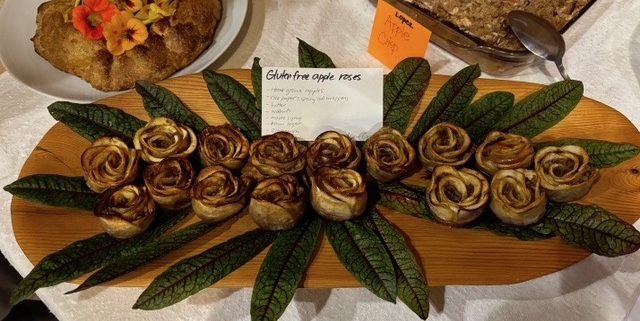Dreaming a World of Local Abundance
LCLT Fall Newsletter 2025
Dreaming a world of local abundance
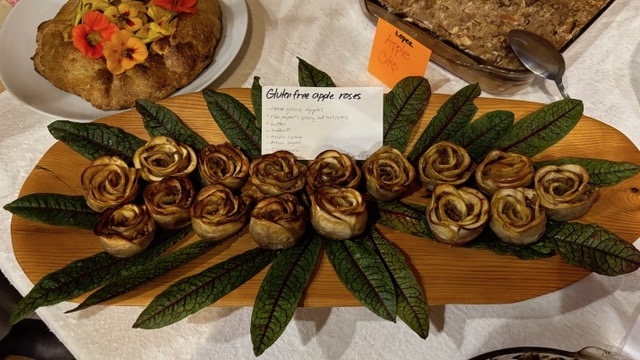
Apple Roses by Chom Greacen, photo by Tracey Cottingham, last year’s Harvest Dinner
“In the Arena of food, the ethical choice is also the pleasurable choice.”
— Krista Tippet in conversation with Barbara Kingsolver, The Ethics of Eating, On Being Podcast, July 15, 2010
LCLT Harvest Dinner
5pm Saturday, October 18, 2025
At the Lopez Center
featuring
Guest Speaker Laurie Bullock of Taproot Community Kitchen
Local Ag Trivia by Faith Van de Putte
Potluck judges Lexi Krauel & Jenny DeWitt
Read on for more details
Dreaming up our World
By Sandy Bishop, Executive Director
A few months ago, a friend introduced me to a fund developer who was relocating from L.A. to Seattle. He posed a simple question to me. He asked what LCLT would do with $10,000,000 then dropped it to $5,000,000 and $1,000,000 and so on. When he works with non-profits, he asks them to be at the ready to answer those questions. It was interesting to be put on the spot and see how easily the answers came. I rattled off amounts for land banking, increasing our endowment, funding for both new construction as well as remodels, funds for farms and infrastructure, and increasing capacity for internships and general skill-building to increase our mutual aid capacity—from land stewardship and forest management programs to more opportunities for cross-generational skill sharing.
Lori Ann David, of Aurora Farms on San Juan Island, recently mentioned the importance of working towards a sustainable sanctuary which will be essential for the near future. She envisions more local foods, different models of housing (such as bunkhouses and boarding houses), and increasing life skill levels. The Gullah peoples of Georgia are also working towards sustaining their culture and offer their wisdom to us. To paraphrase, they have realized that in order to keep the character of our communities, we need to keep farmers on the land and keep that land in food production – for economic and environmental reasons, and for cultural preservation.
Creativity is key to a world unfolding so dramatically around us. Unlike the survivalist movement, science has now taught us that life is interconnected, and the whole is greater than the sum of its parts. It seems humans are always relearning how to work together, whilst the greater eco-system comes to it effortlessly. For example, the trees in the forests know that one does not exist independent of the others.
LCLT is among the many entities forging new frontiers to see how we can better serve each other. From electric carsharing, to building homes together and developing democratically managed co-ops, to preserving farmland for increased food security, we look for ways to engage and influence a new emergent world. We hope you will join us in dreaming up our world.
Housing to Strengthen the Local Food System
Forest House for Sale
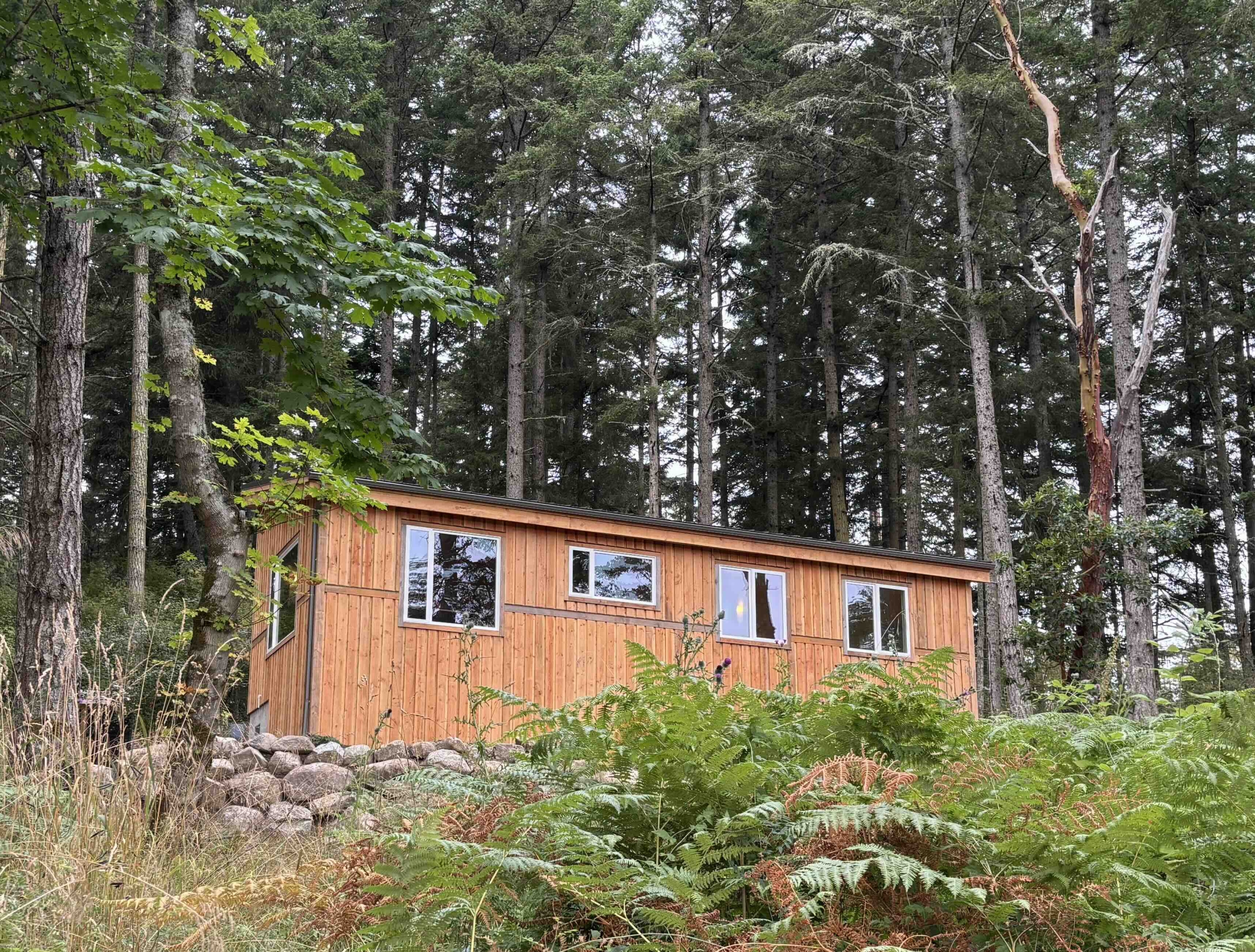
The Forest House on Lopez Sound Road, designed by Ets Architecture

To help strengthen the local food system, LCLT built the Forest House. The home is for sale for $340,000 to a one to three-person household. At least one member is required to be employed in some aspect of the local food system. Learn more about how to apply to purchase this home here.
We’re Hiring!
LCLT is hiring a Stewardship Manager. If you’re interested in joining our team, apply by October 10th. Job description & details available here.
LCLT Harvest Dinner
Saturday, October 18th, 2025
At the Lopez Center
Doors open at 5pm
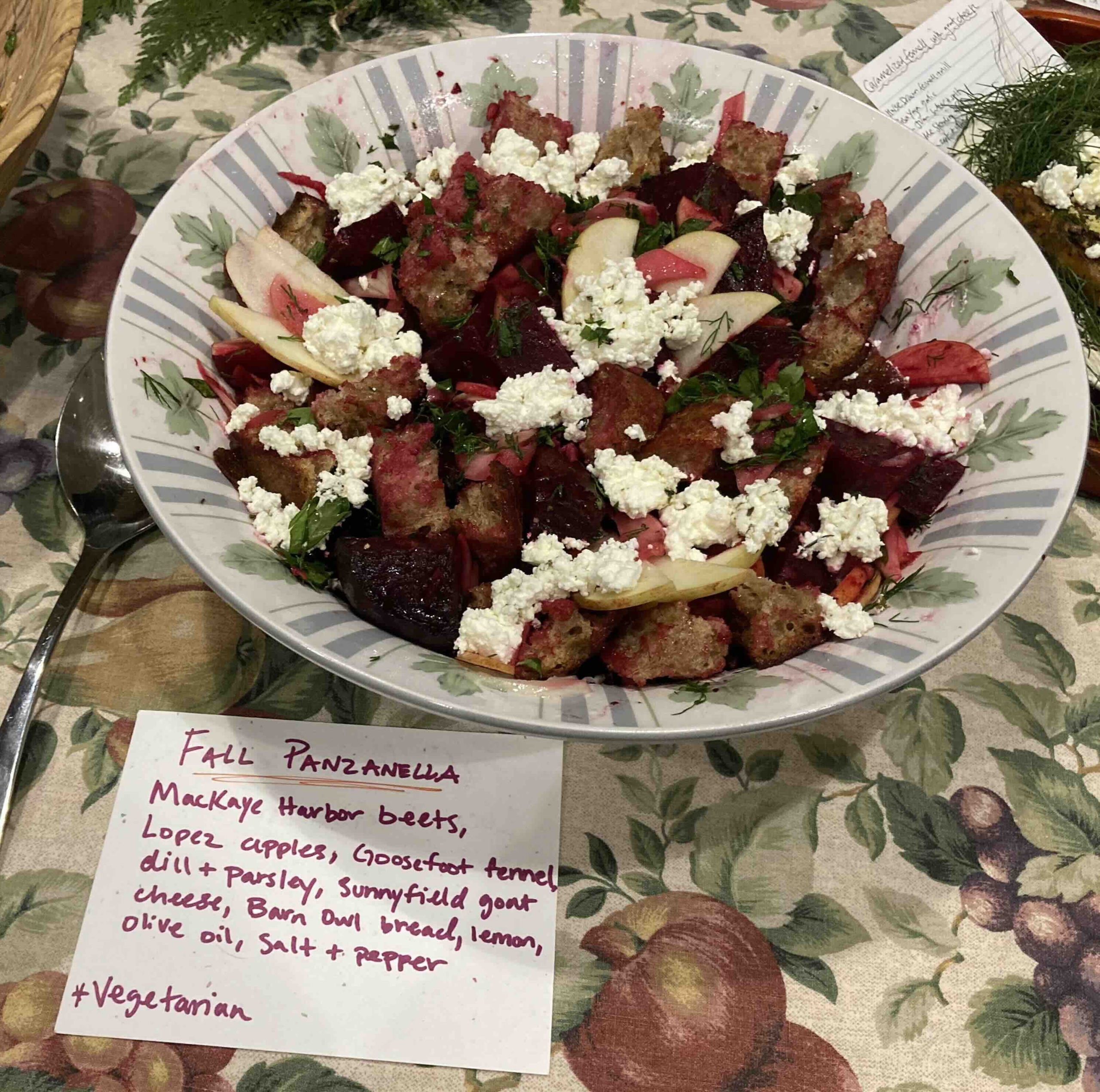
Join us for the “world’s best potluck” to celebrate local farmers and island grown foods! In honor of the bounty and abundance on Lopez, we encourage you to make a dish containing local ingredients, large enough to share with 6-12 others. Island farmers Lexi Krauel (who works at Goosefoot Produce), and Jenny Dewitt (co-owner of Indigo Moon Farm and Fiber) will serve as judges and present prizes in categories such as best use of local ingredients, most beautiful display, and best dessert – so get creative! Faith Van de Putte of Midnight’s Farm and Coordinator of the Agricultural Resource Committee will share local ag trivia, followed by a presentation by Laurie Bullock, Operations Manager of Taproot Lopez Community Kitchen.
Doors open for the Harvest Dinner at 5pm. Max capacity is 125 so come early to ensure a seat and give the judges plenty of time to view the dishes. Dinner starts at 6pm with awards announced after the meal, followed by presentations. Wine will be available for purchase. For a zero-waste event, please bring your own tableware (cutlery, plate, cup, etc).
Harvest Dinner Presentation by Laurie Bullock: Taproot Community Kitchen – Strengthening the Lopez Food System
Taproot is a non-profit shared-use certified commercial kitchen and food processing facility available to the community, located off Dill Road. The space is available to rent by the hour to home cooks for personal use, farmers, non-profit organizations, and local business owners. Taproot has played an important role in strengthening the local food system by providing space and mentorship opportunities to local business owners. The kitchen has been undergoing major renovations and its services will be greatly expanded. Laurie Bullock, Taproot’s Operations Manager, will highlight the non-profit’s latest milestones and plans for the future. Natalie Wilson, former owner of Just Heavenly Fudge and LCLT resident, will also join the discussion to share her experience with Taproot as a business owner – from moving out of the village and setting up her operations at Taproot Community Kitchen.
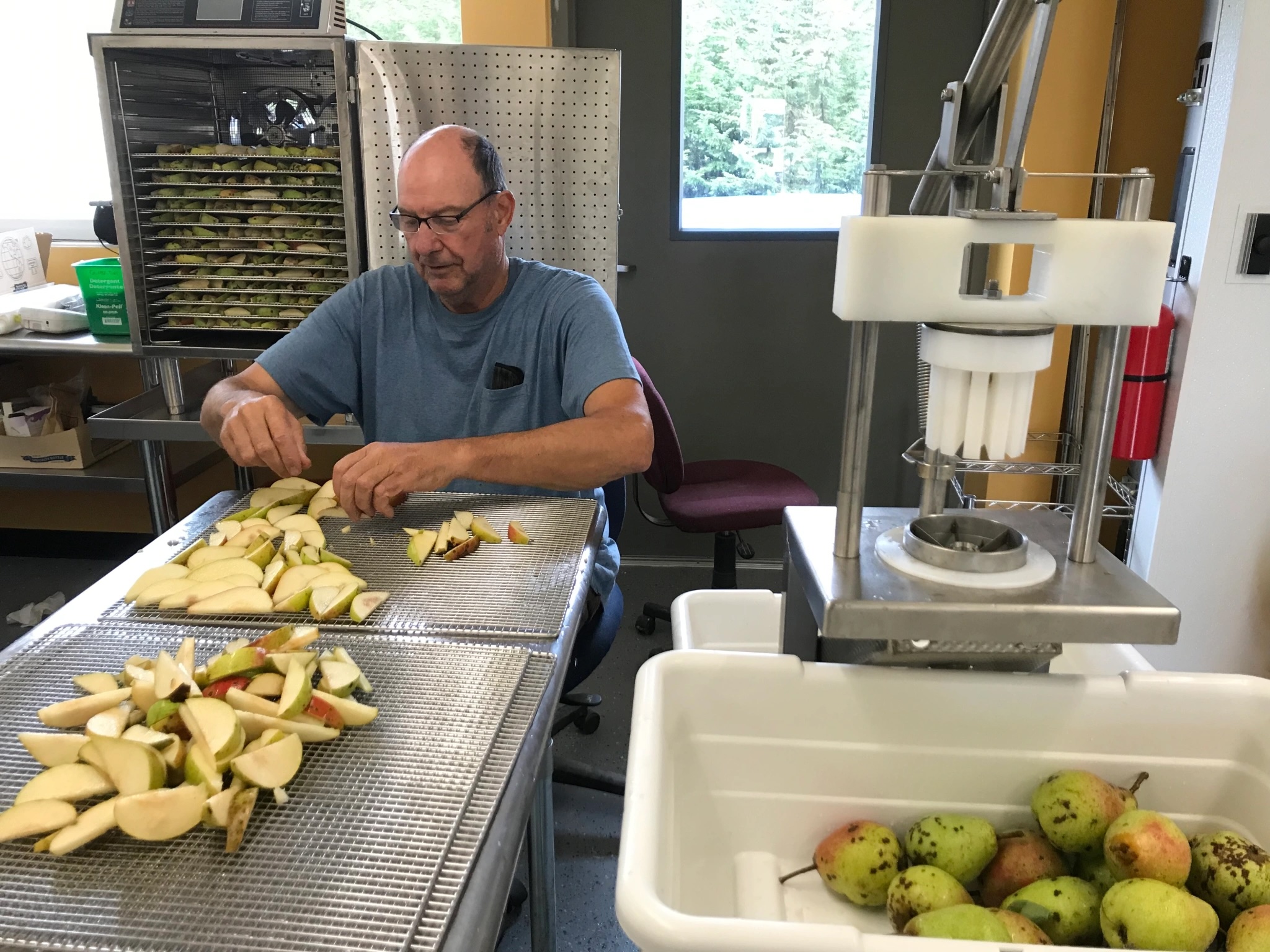
Jim Birkemeier prepping pears for dehydration using corer/wedger equipment
Photo courtesy Taproot website
A Fall Update from Stonecrest Farm
Photos & text by Meike Meissner
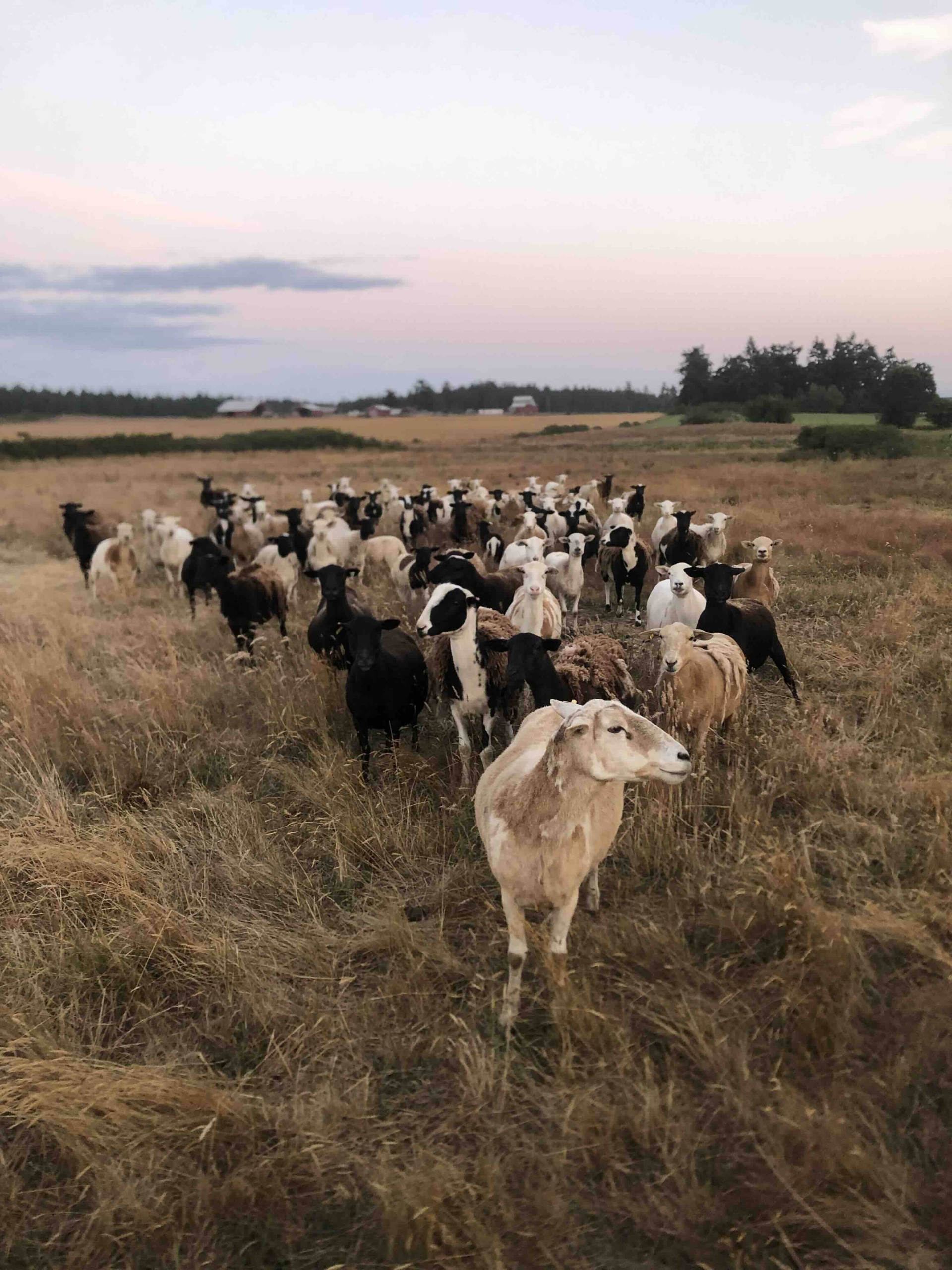
Late summer grasses still produce good green forage for our hardy sheep
Here on Stonecrest we are welcoming fall rains and preparing the farm for the wet months ahead. Part of this process has been managing soil fertility, and this summer we housed all of our chickens into three “tractors” – mobile hen houses that are moved daily across the ground – in order to strategically fertilize the fields and to reduce predation by eagles. Groups of young egg layers and meat birds have been adding nitrogen to the ground and enjoying life outside at the same time. We will be building a permanent chicken run to house the birds this winter and have a collection point for their garden-friendly manure.
Our sow and her annual litter of piglets are busy digging up spots of roses and brambles, growing quickly with scrap veggies from Blossom Grocery and the leftovers from the Noodle Bar/Galley. Off farm, our cattle and sheep are still out grazing on leased land south of us that is showing tremendous fertility after several years of managed grazing. We thank our land partners (Marty, Karen, Tim, Denise, Carol, Tam & Doug) for helping us raise great meat!
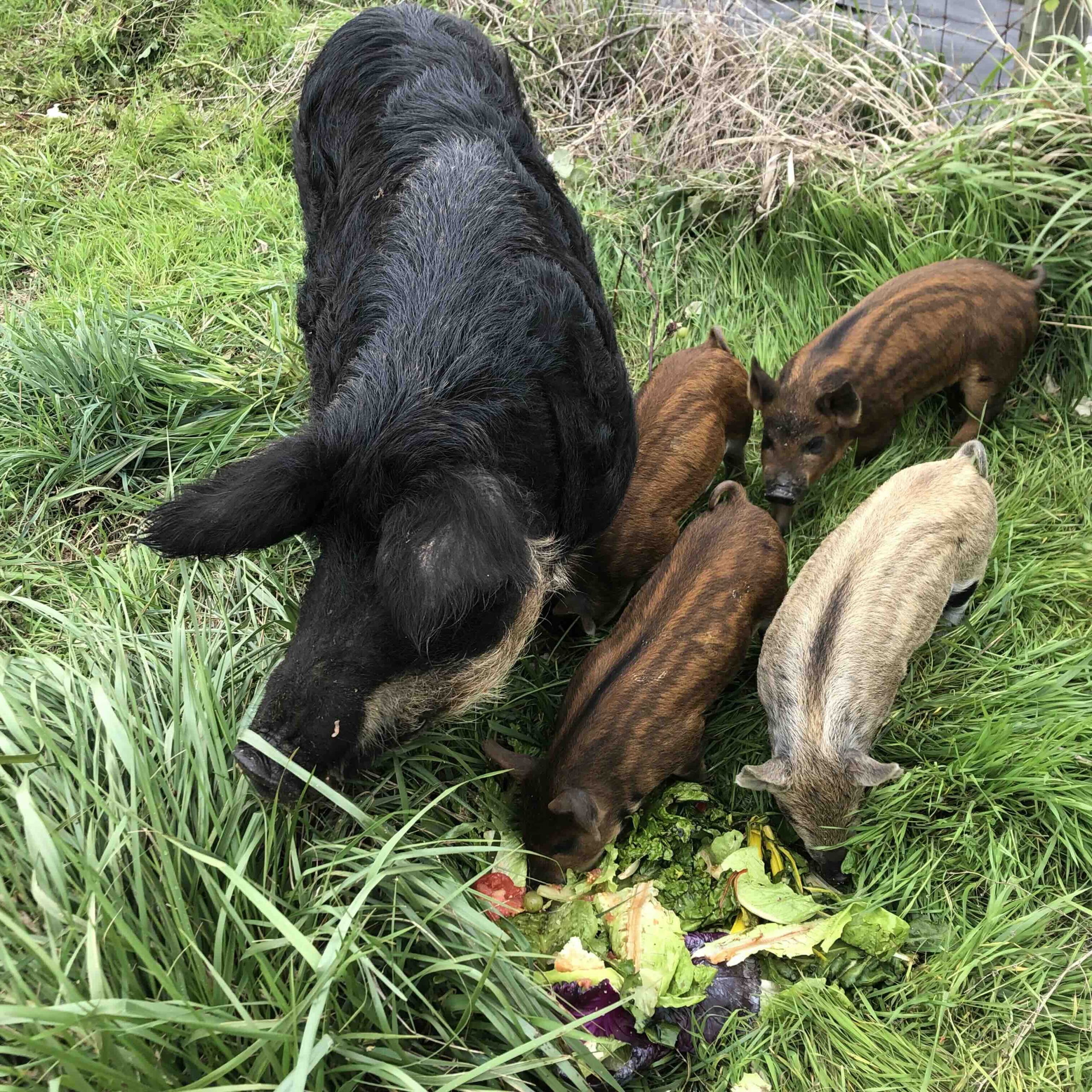 Frau the Stonecrest Sow and her annual litter of feisty piglets eating a varied diet of veggies, food scraps, and sprouted barley
Frau the Stonecrest Sow and her annual litter of feisty piglets eating a varied diet of veggies, food scraps, and sprouted barley
In other news, we’re calling 2025 the Year of the Big Fruit. Anyone who’s been on Lopez lately knows why: the plums, apples, and pears, the berry bushes, strawberry plants, wild hawthorns, rose hips, and blackberry vines, each and every one, are loaded with a bumper crop. We have started declining offers of windfall fruit for the pigs as storage space for hundreds of pounds of bruised apples and watery Asian pears is limited, and to be honest, the pigs are starting to turn up their snouts at their daily fruit ration. The incredible bounty of the season has us reflecting on what a truly special place the San Juans are for growing and raising food, a reminder that our climate and location make for some amazing meals, and that the agricultural heritage of Lopez in particular is one to be cherished and protected.
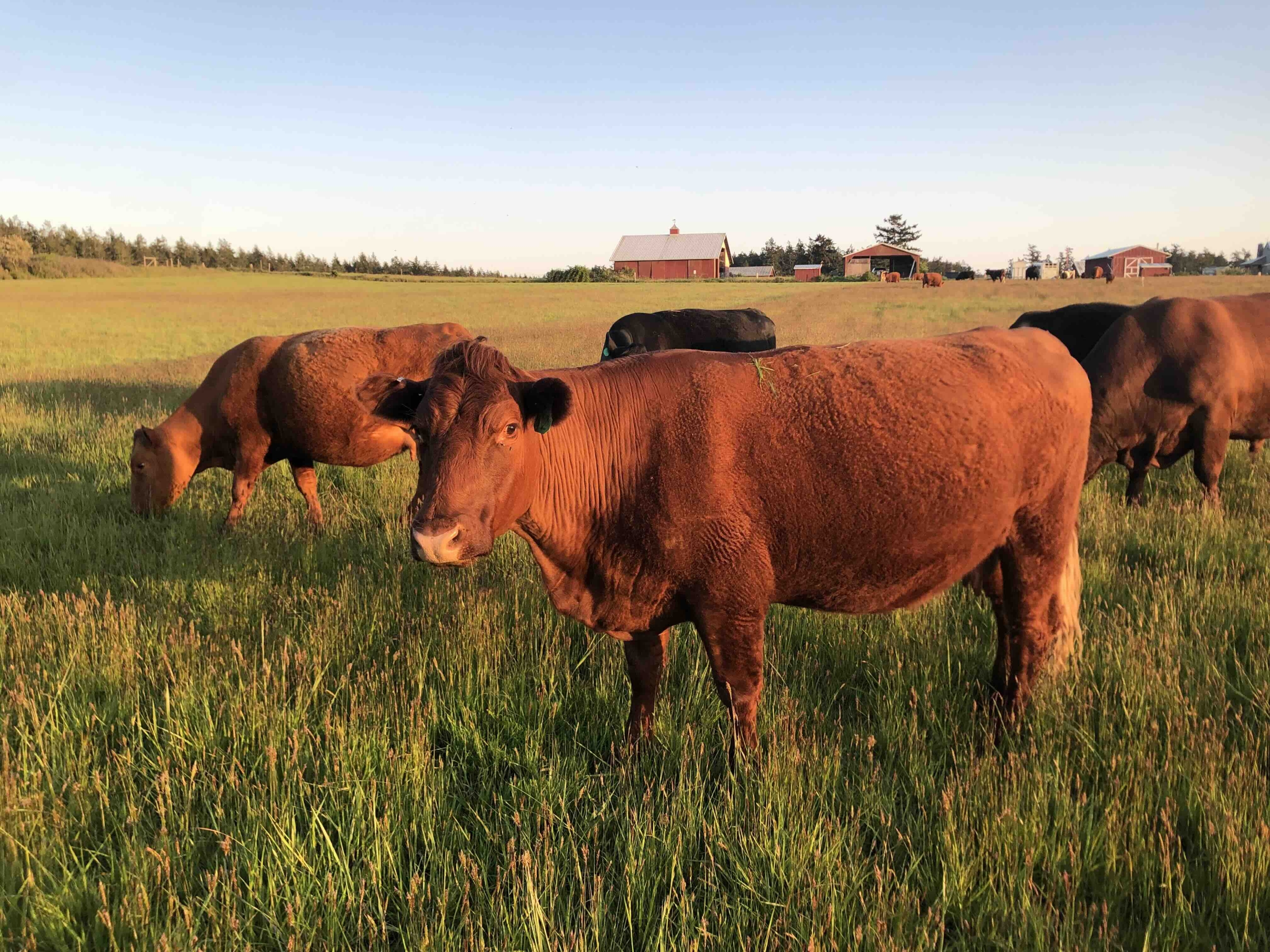 Early summer cows on the lower field of Stonecrest: the Red Devon breed continues to be a great cow for our climate.
Early summer cows on the lower field of Stonecrest: the Red Devon breed continues to be a great cow for our climate.
That said, even small farmers on a small island are impacted by the global agricultural business of feeding people. The price of processing meat continues to rise rapidly and the price of cattle on the open market is at record highs. The U.S. currently has the smallest national beef herd in 73 years (drought, farms/ranches being sold for real estate, ranchers retiring, etc.) but the demand for animal protein, beef in particular, is not decreasing. Add to this the closure of the Mexican border to all livestock due to an outbreak of the New World screwworm until 2026 and most consumers, both on island and on the mainland, are facing the highest prices on beef ever in their lifetimes. For us locally, the added strain of the Island Grown Farmers Cooperative selling its Mobile Slaughter Unit effectively ended the low-stress on-farm animal slaughter that was a central tenet of our business. We have chosen to continue slaughtering with IGFC by trucking animals to Burlington, so we can then sell meat on island. We are also selling live animals at auction and to families who want to save money by butchering at home. We will continue to work with other island farmers to try and solve the local meat processing puzzle, and we’ll continue to build soil and grow grass for the healthiest beef, lamb, and pork possible.
 When life gives you lardy hogs, make soap! Lard soap is a gentle, effective and traditional cleanser
When life gives you lardy hogs, make soap! Lard soap is a gentle, effective and traditional cleanser
The months ahead will have us focusing on fencing projects, feeding animals, removing more blackberry plants, early winter lambing, and continuing to make and sell our Fat & Happy brand of soaps and tallow balm. Lamb and beef will be back in stock soon and look for us at the Little Winter Market, on the San Juan Islands Food Hub, and at the Barn Stand on the farm.
Life on Grayling Lane
Photos & text by Sage Dilts & Nathan Hodges
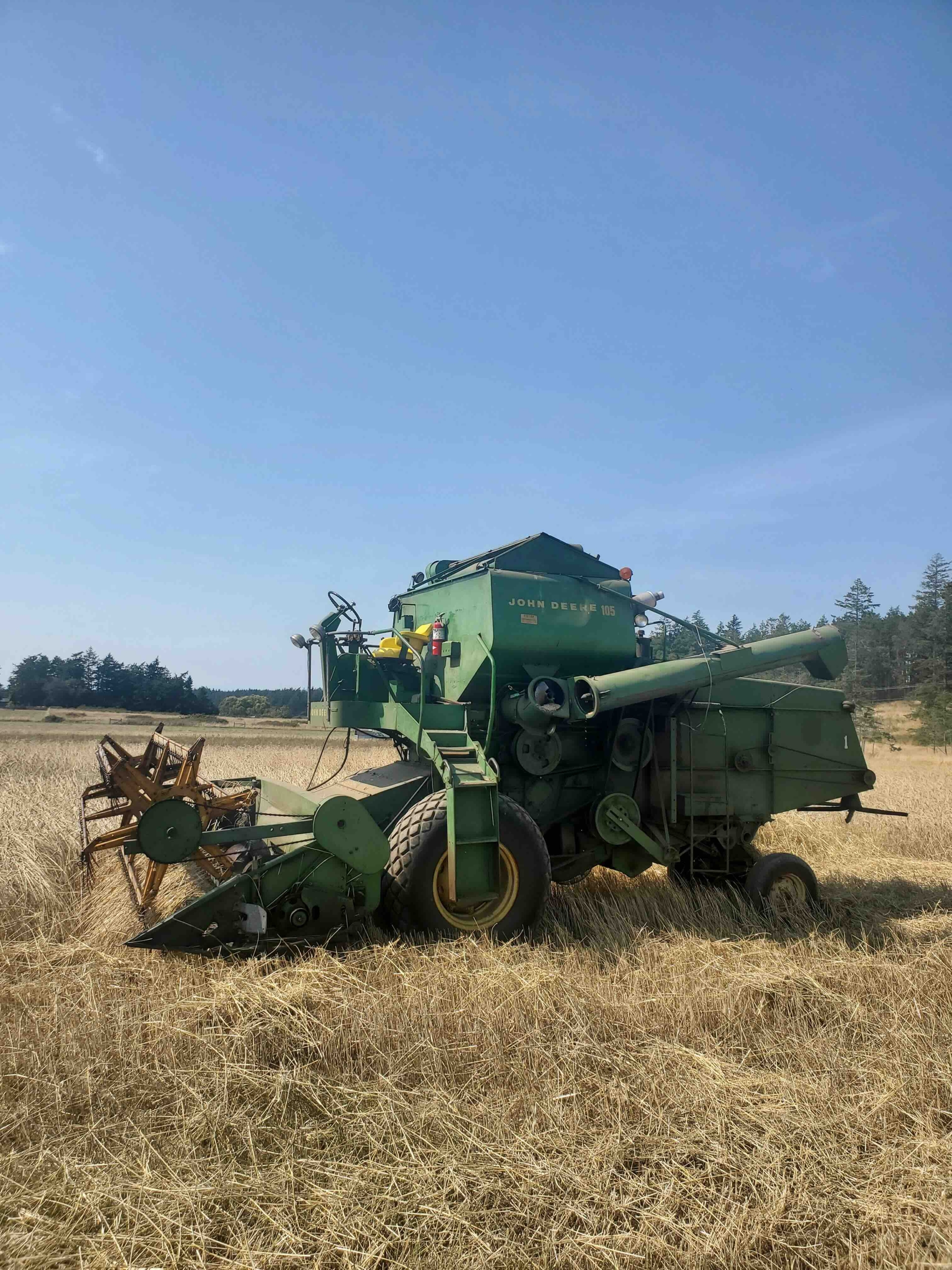 Combine in the Field
Combine in the Field
Here at Grayling we’re wrapping up the grain harvest for the year – storing seed, cleaning seed, and getting a taste of this year’s grain in the bakery. There is a relief at the end of harvest but not necessarily a break as the needs of the grain cycle flows fairly seamlessly into fall cultivation and planting. We’ll plant some fall wheat but quite a few of our fields will get planted with winter field peas – a cover crop that does well in our cool wet winters and can really take off in the spring, supplying the fields with nitrogen and organic matter for the next year’s crop of wheat. As we have all noticed, it has been dry – the rain seems to evaporate before the drops even have a chance to fall, and while we’d normally be planting in early October the ground is still too dry – shortening the window where a seed has a chance to germinate and sprout and put on some growth before it gets too cold and dark. So it goes – the weather remains the great decider and while we do our best to catch the windows of opportunity, sometimes it doesn’t go as planned.
Like this past week, the forecast had a good half inch of rain coming in followed by some warm sun – what looked like a perfect planting window. So we drove our old tractor and disc up the hill and turned in a mixed cover crop that we had planted in the spring. It worked up nice and made a fine seed bed – but the rain didn’t fall as predicted and the wind came in strong – blowing little dust devils up from the newly worked ground – disheartening. We should have waited, but that’s only easy to know in hindsight. With the fall planting window shrinking, there’s a strong sense of urgency – making the right decisions at the right moment with the right equipment is the essence of grain farming and we certainly don’t have all the answers.
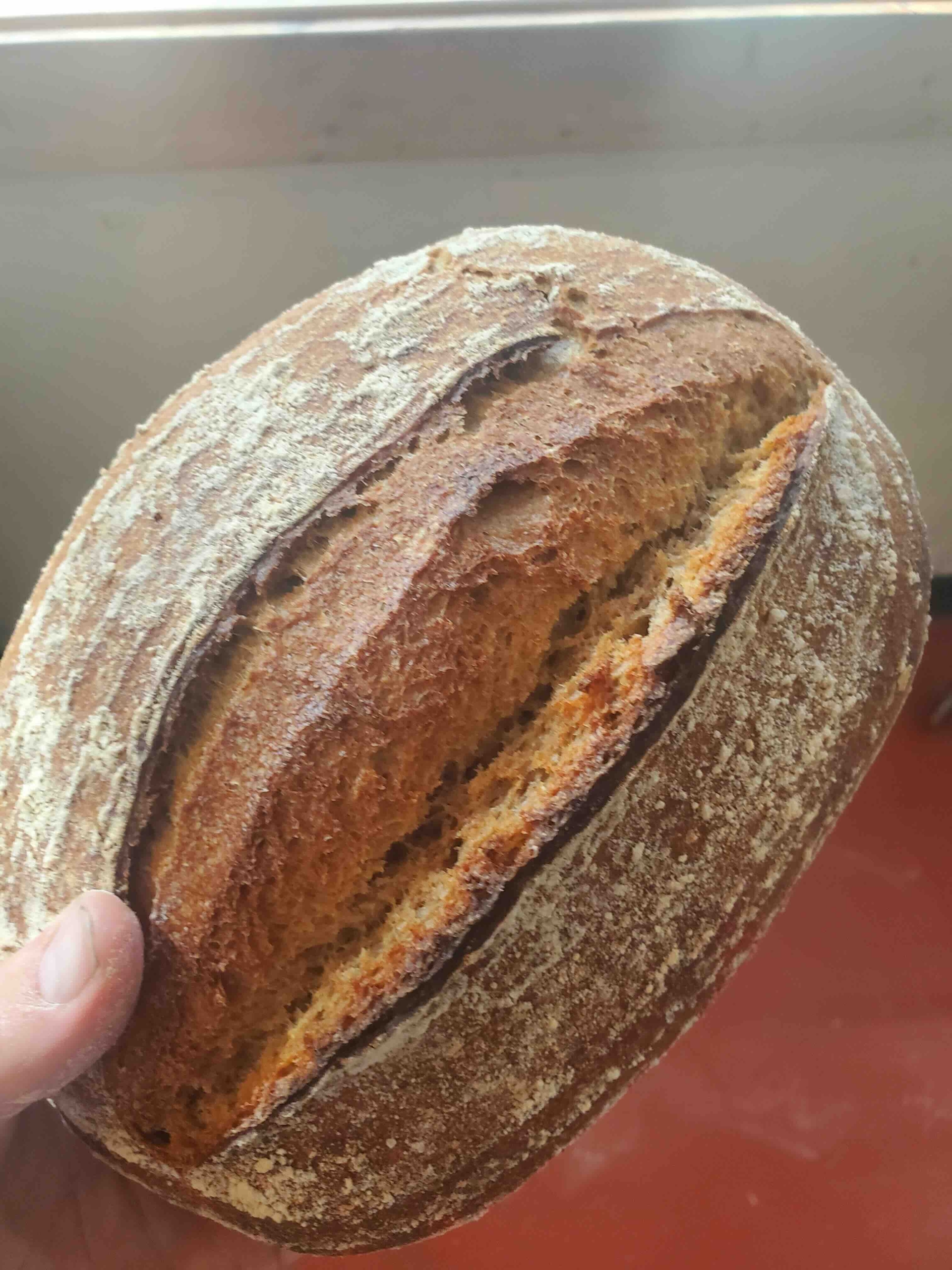 Fresh Bread
Fresh Bread
We fall into the category of first-generation farmers (or at least a few generations have been skipped over and the knowledge has been lost). Typically first generation farmers are younger folks without a lot of resources for investment and infrastructure and equipment who nevertheless want to make a go at growing food for their communities. This is not a recommended position to start farming from but that hasn’t stopped us yet. It just means that we have a lot to learn, only yearly cycles to learn it with, catch-as-catch-can information from those who have been doing it for longer, and we get make-do equipment when we absolutely need it. It’s a smarter and more viable option, popular here in the islands, to farm starting with the resources needed to invest in the necessary infrastructure and equipment – yet here we are, with this passion for local food and supplying our bakery with heritage grain that we grow. We get a lot of support from this community for this venture, and while it might not make the most short term economic sense, we try and take the long view- where farms and farmland here in our islands are thriving and abundant, where the land is protected, where the land and equipment and knowledge to grow our own food is held by the community and can be passed on to the next generation of farmers, and where the highest quality most nutritious local food is accessible to all.
News from Still Light Farm
By Lena Jones
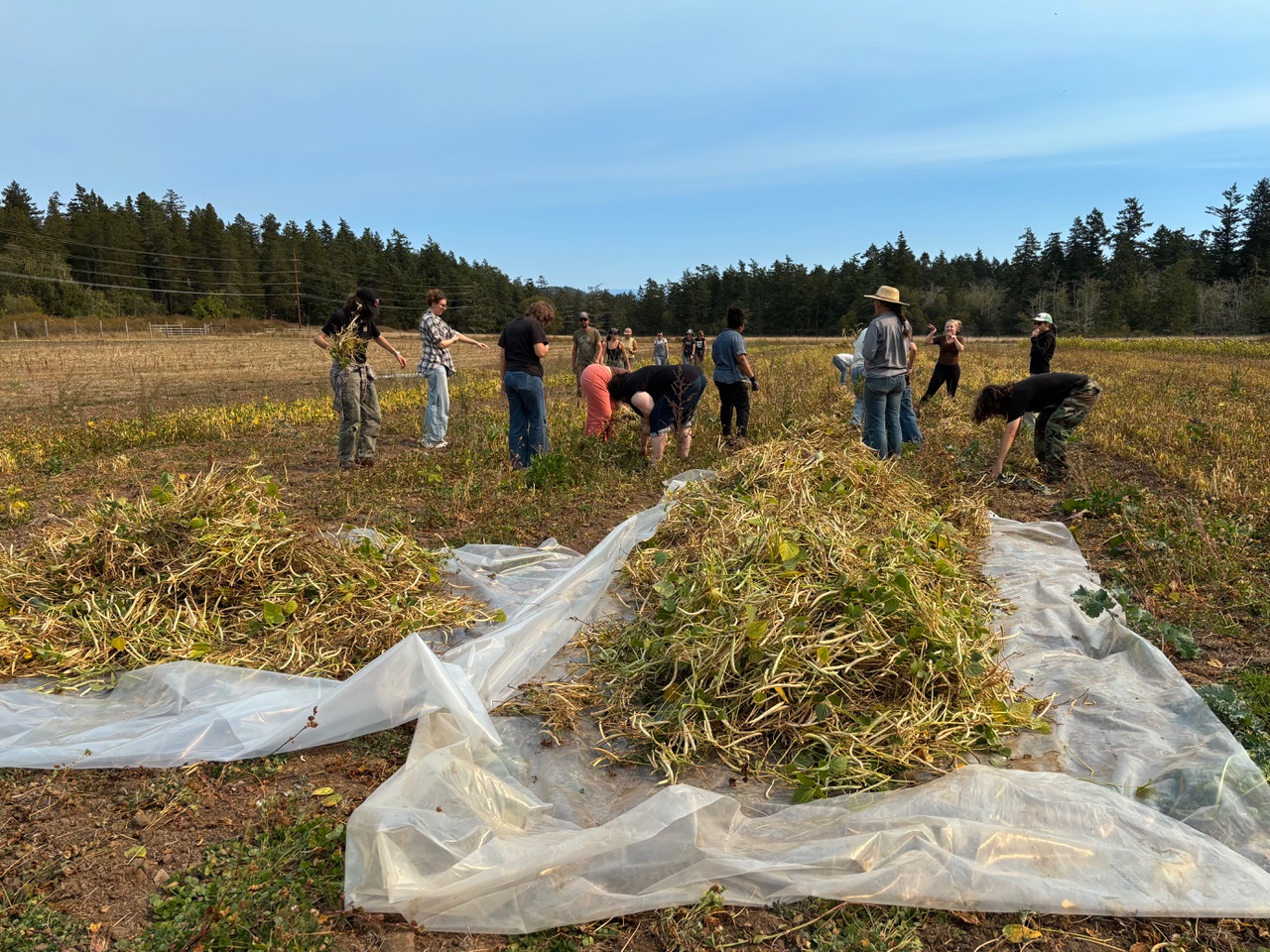
WWU Food Coalition Students helping to harvest beans, photo by Breton Carter
In late September we wrapped up the nursery season, after 28 weeks of deliveries. What a great year! We love growing vegetables and herbs for local gardeners. Sunset Builders Supply has been an encouraging partner as we grow this enterprise, and we are grateful for all they do to support Lopez-grown plants. This year we offered several new varieties, specializing in regionally adapted plants that have been bred by nearby seed producers. We’ve expanded our herb production and are starting all herbs in the nursery, from seed and cuttings. Next year we’ll have strawberry plants produced in the nursery too. We love to hear from folks about varieties they’re looking for, so don’t hesitate to drop us an email. One of the highlights of our nursery year was the tomato sale, where we got to chat in person with gardeners about their favorite varieties and took copious notes on what folks are looking for (more dwarf tomato plants, coming up!) We’re also enjoying growing starts and plugs for local farmers and hope to do more of that in the coming years.
In mid-September, we hosted a field day on the farm with students, faculty, and staff from Western Washington University. The group was a collaboration between a class on regional food systems and the kickoff of the new WWU Food Coalition, and they brought a diversity of experience with them. We toured the farm, talked about growing food here on Lopez and throughout the islands, and then headed out into the fields, where they helped harvest dry beans. At lunch, we were joined by other producers and local agriculture folks, including LCLT’s Breton Carter, and had a lively conversation about farming, local food system challenges, and the potential for future coordination between Western and the farming community on the islands. After lunch, we toured the nursery and ran a little seed demo, harvesting, threshing, and winnowing calendula seed. Field days are a great chance to step back from the day-to-day chores and remember the ways our work intersects with the wider community. Many thanks to WWU’s Center for Community Learning for organizing.
We were grateful for the extra hands on the bean harvest, which we finished in late September. This year we grew seven varieties of dry beans on one acre. For the first time, we dry-farmed the beans, something we’d tested out on one variety the previous season. We were prepared to run irrigation out if we needed to, but a few well-timed rains in early June and early August gave the beans the water they needed. Our soils are heavy and hold water late into the spring, so the beans seemed to thrive a little drier. We’re not sure this will work every season, but for this year, it was a success. The beans are looking beautiful as they come in from the field. We’re now threshing and winnowing the varieties, one of our favorite parts of the work. There’s such delight in running your hands through bins upon bins of clean beans. Bean Shares will be available starting in November; best way to get a share is to be on our newsletter list.
Summer Internship
This summer, LCLT hosted 6 interns in the Sustainable Agriculture and Rural Development program. Interns spent time at farms across the island, including Arbordoun, Goosefoot Produce, Horsedrawn Farm, the LIFE School Garden program, Midnight’s Farm, and Watmough Bay Farm. The internship program is a reciprocal opportunity, where local community members open their homes to provide housing, farms benefit from additional hands on-site, and interns gain real-world experience in agriculture, learning about local food systems, and this year, visiting organizations to explore “how to build a sustainable island community.” We’re deeply grateful to all who helped make the internship program possible!
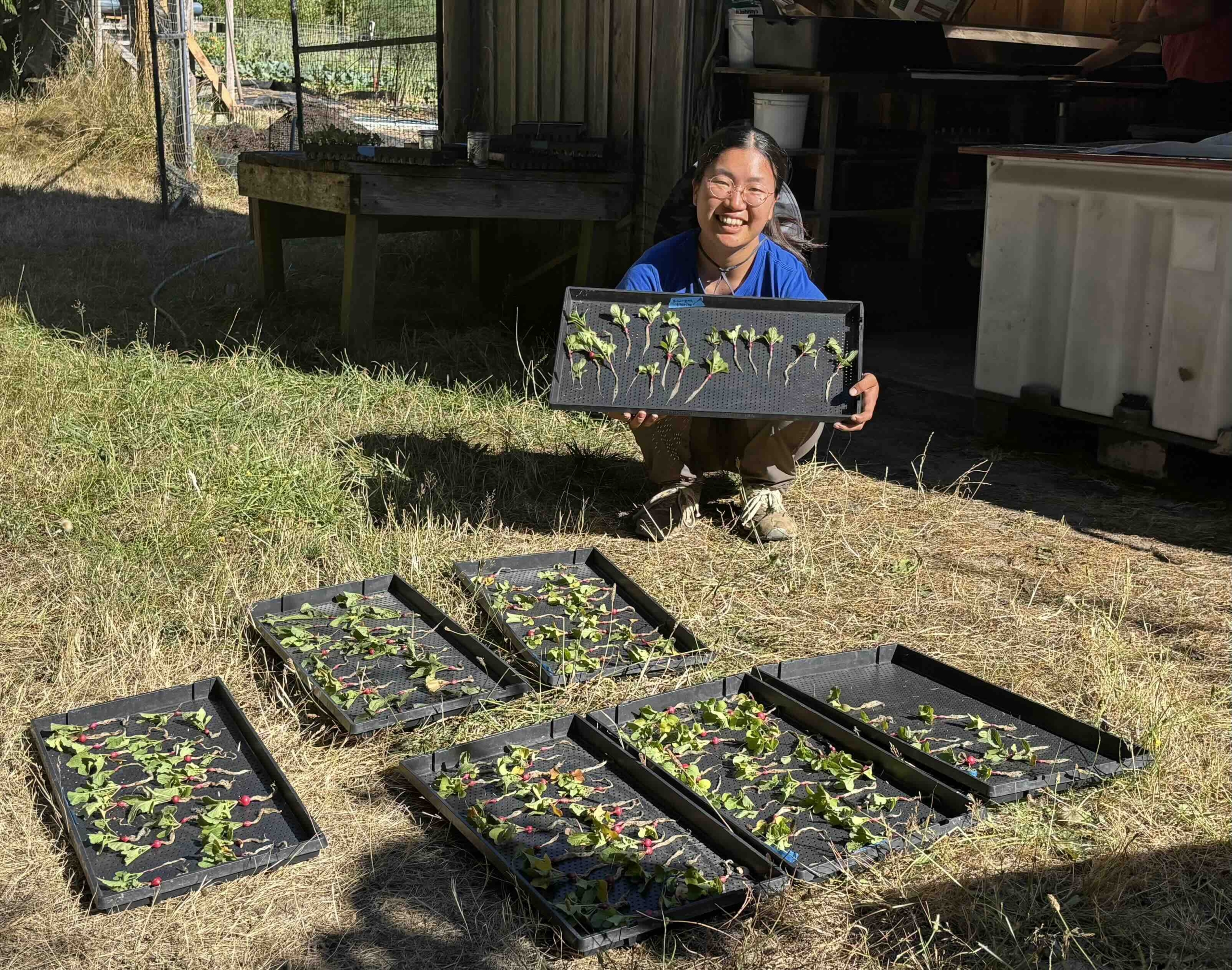
“My internship experience was fascinating and lifechanging. I learned a lot about agriculture, and I loved learning about food systems on Lopez in terms of how food is connected to communities, culture, history, and health of the planet. I also think LCLT plays a critical role on Lopez, contributing to bringing community together, making it resilient and vibrant.”
– Kanami, intern at Midnight’s Farm, Lopez School Garden & Watmough Bay Farm pictured above with her research experiment on radish growth in potting mix combinations.
JazzGarden 2025 – Many Thanks!
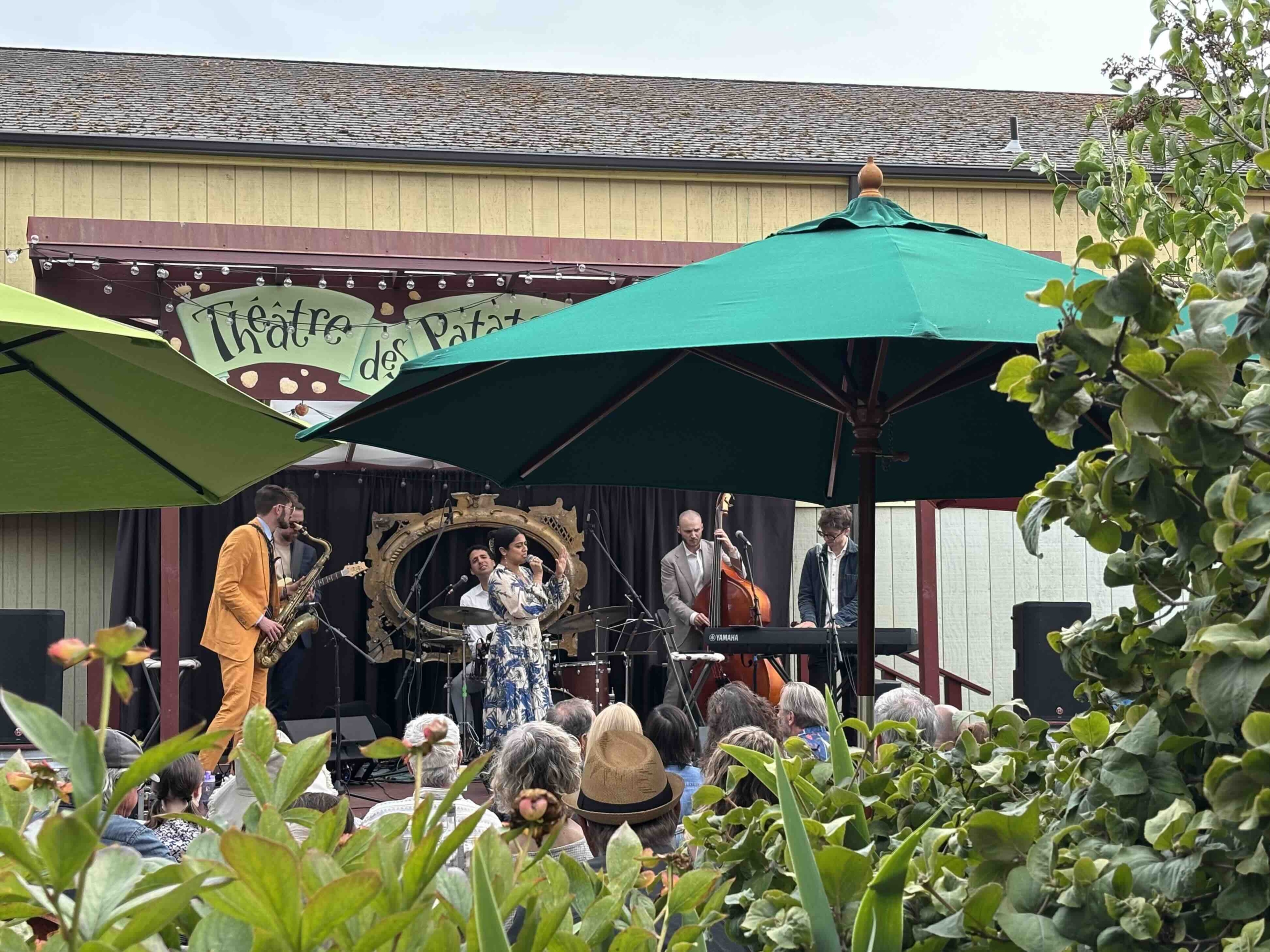
Thank you to the many people who joined us August 8 & 9 at LCLT’s fundraiser events, JazzGarden at Vita’s and JazzBall at Joe Schneider and Kim Clements’s home. With your support, we were able to raise over $200,000. “Which” in Bruce Bott’s words, “might sound like a crazy astronomical amount. But if you’ve ever built a house, you know how that process inhales money. As I have said before, I’ve been in my land trust home for 30 years. This is an organization that I truly believe in. It has made a huge impact in so many lives. I’m not sure Vita’s would exist if not for the land trust.” Thank you Bruce, Joe, Kim, and everyone who came out to support LCLT!
If you couldn’t join us at JazzBall, but would still like to make a contribution, we invite you to donate at the link below.
Northsound ACH Grant Award for Crayfish Way
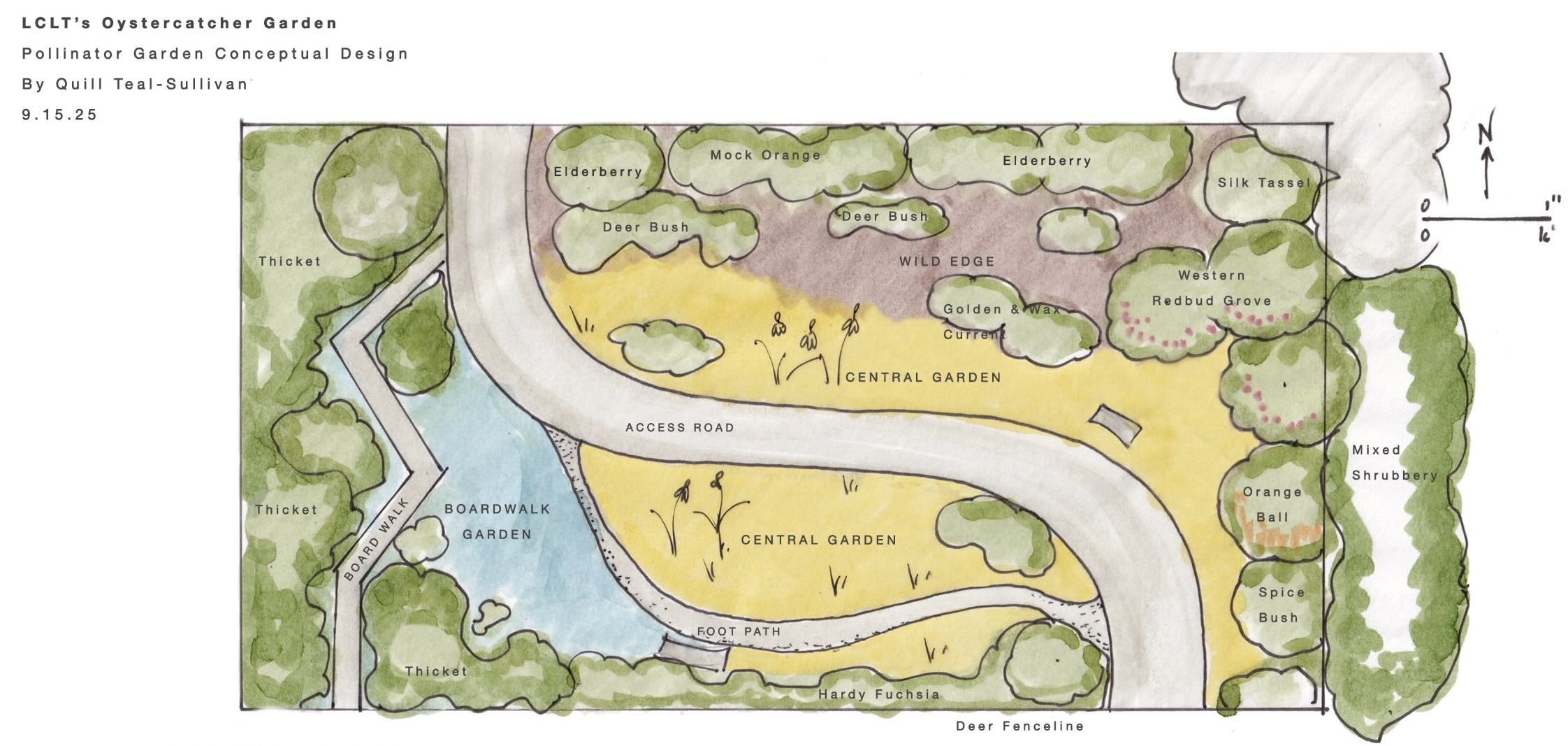
This summer, all the residents at Crayfish Way settled into their new homes. Now that construction is complete, the next phase will focus on landscaping around the homes. As part of this — we are pleased to announce that LCLT has received a grant of $47,200 from the Northsound Accountable Communities of Health! The grant will support building raingardens for stormwater management and establishing a pollinator garden with native plants in the area adjacent to the new homes. LCLT is working with the San Juan Islands Conservation District, and Queen Valley Farm for the landscape plan. If you’d like to volunteer to help us plant – please reach out to Breton at LCLT25@rockisland.com
Welcome Helen!
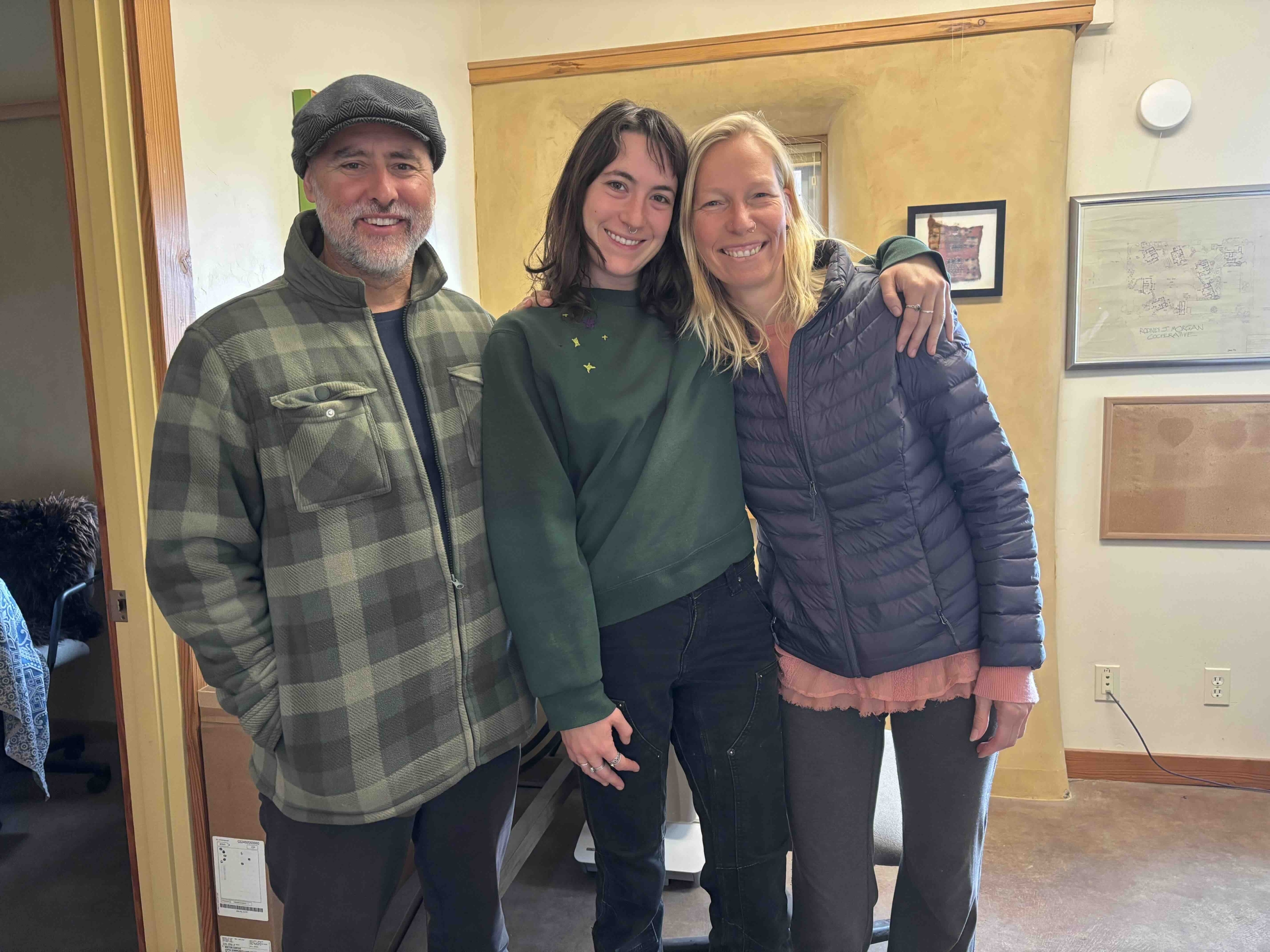
The Innisfree Housing Cooperative welcomed new resident Helen (center) pictured with neighbors Diano and Marjorie
International Exchange – A Visit to the Brussels CLT
By Breton Carter, LCLT Assistant Director
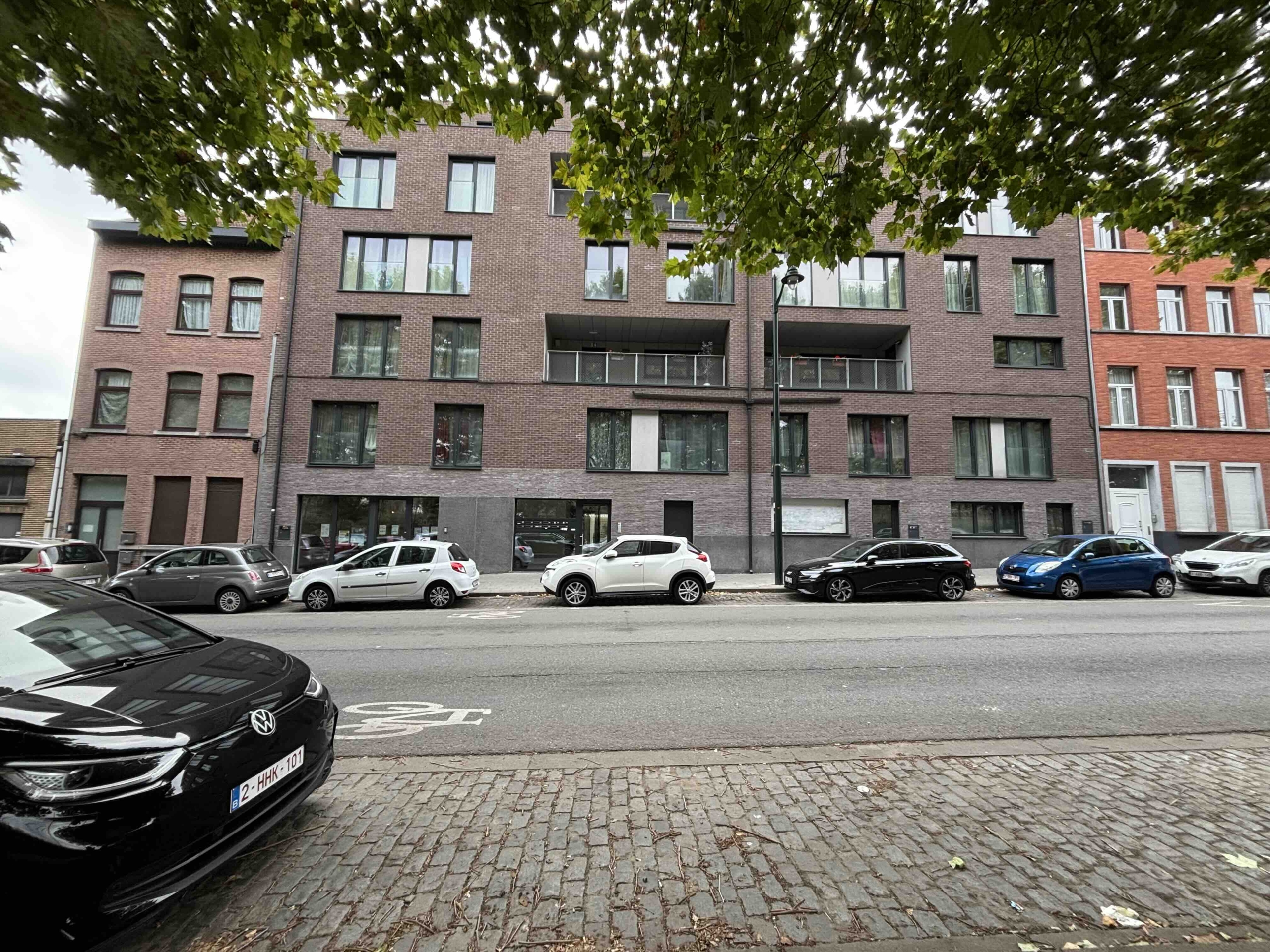 Street view of the Arc-en-Ciel apartment complex
Street view of the Arc-en-Ciel apartment complex
A world away from island farms and cottage homes, this September my husband Evrard and I took the metro from his family’s home in the south of Brussels, Belgium, to the Molenbeek neighborhood. We passed lines of rowhouses, some new, and many historic, influenced by art-nouveau architecture, to arrive at what appeared to be a very standard apartment complex with brown brick, lines of tall glass windows, and small European cars parked out front. Across the street was a local park, converted from a railroad, the tracks still visible between cobblestones. Molenbeek is one of the most diverse neighborhoods in Brussels with many immigrant families. We were there to meet Geert (pronounced “Hairt”) of the Community Land Trust of Brussels to tour the Arc-en-Ciel (“Rainbow”) apartment complex. We were joined by a group of Urban Studies & Architecture students and professors from Rotterdam, part of a special class focused on Community Land Trusts. By chance, one professor had interviewed Sandy, and another student had included LCLT in a research study.
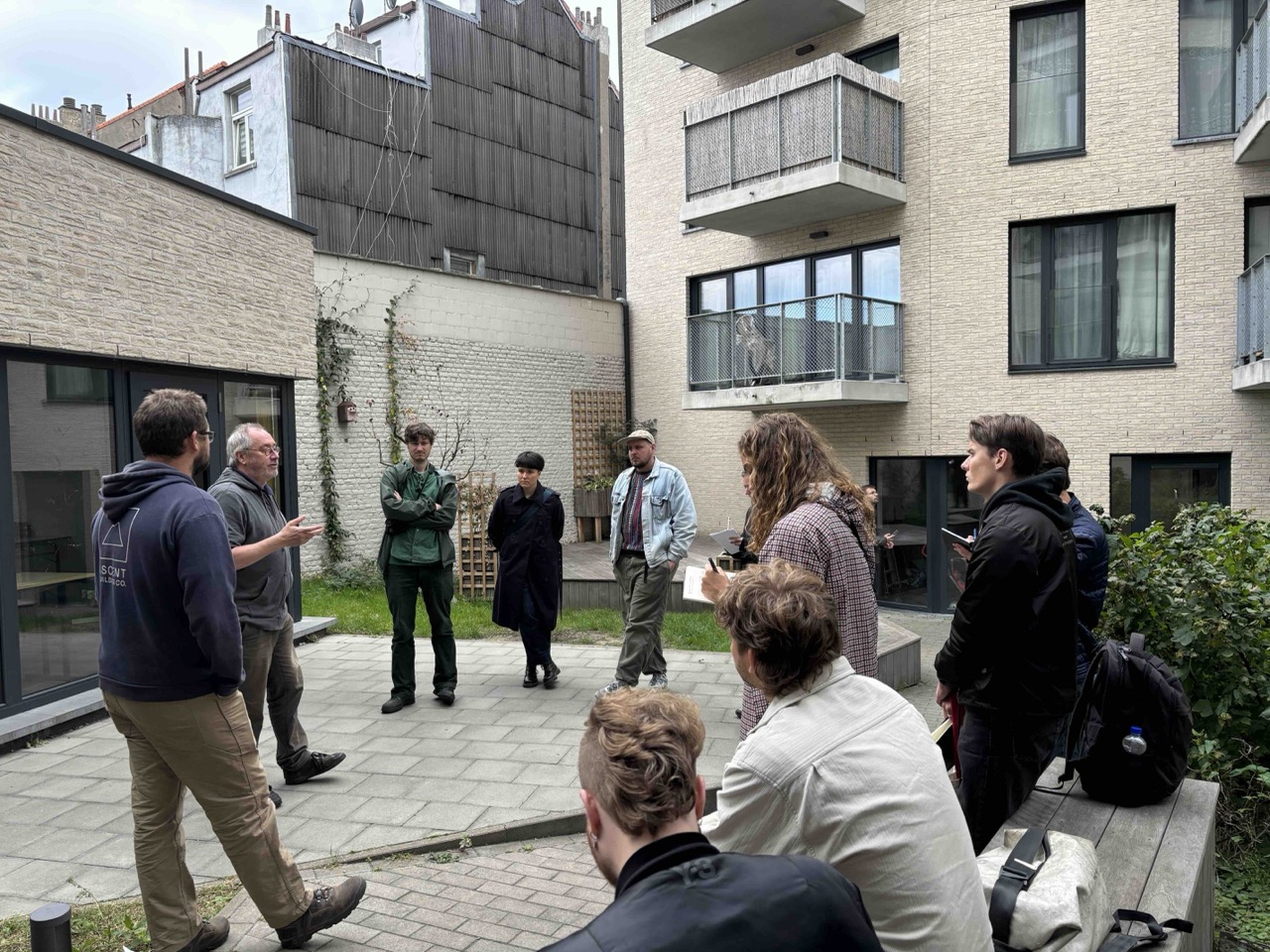 Left to right: Evrard, Geert, and the Rotterdam professors & students inside the Arc-en-Ciel courtyard
Left to right: Evrard, Geert, and the Rotterdam professors & students inside the Arc-en-Ciel courtyard
Geert arrived by bicycle and led us through a hallway to a courtyard behind the apartments. On two sides stood tall apartment buildings forming a V-shape around a lush community garden with currants and fruit trees. The 32 apartments each had windows facing the courtyard and small balconies, some with tables and chairs or a BBQ grill. On the third side, was a small stage and a shorter building, used as an indoor community space, and an office rented by an organization that provides services for women. Geert shared that all these elements were ones the residents themselves had advocated for in the initial design process before construction began. The courtyard proved to be essential in 2020 when residents moved in, and children had access to green space.
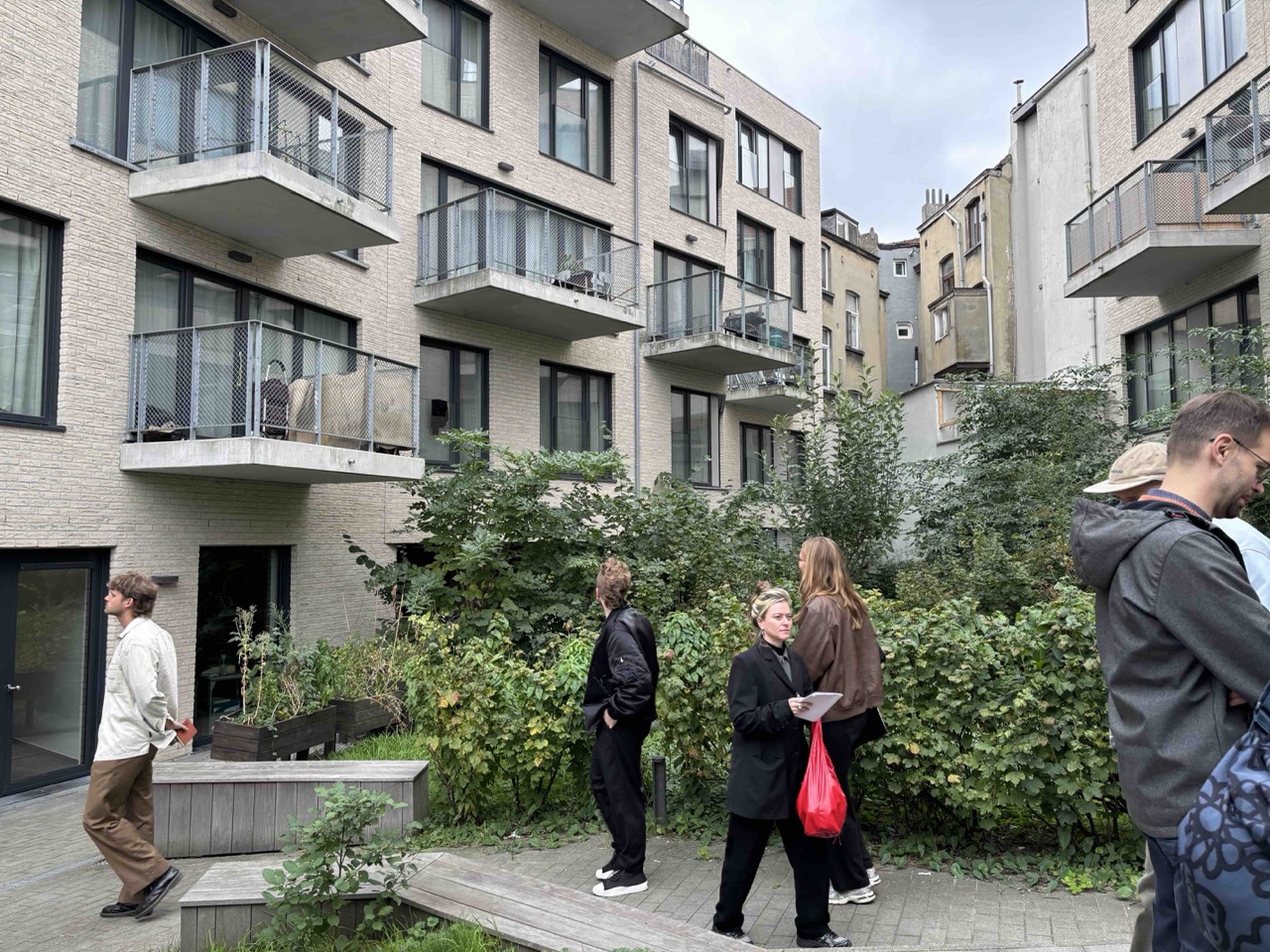 The Garden Courtyard
The Garden Courtyard
The Brussels CLT was established in 2012 and grew out of local activism. While there is a rich history of social housing and cooperatives in Belgium, the city wasn’t keeping pace with resident needs and the CLT founders advocated to remove land from the speculative market and increase access to affordable housing for low-income residents. Between 2010 and 2020 rent has risen by 83% in Brussels (five times more than inflation and three times more than the average income). Today, the Brussels CLT provides 107 homes to over 450 residents, and another 84 are underway, but the need is still large — there are more than 1,000 people on their waiting list.
Like the Lopez CLT, the Brussels CLT seeks to find creative solutions to the housing crises, the inequalities of growth, and to climate change. All of the apartments follow strict environmental standards aimed towards net-zero energy readiness. Residents are also actively engaged in the community, running after school programs, shared electric vehicles, bike riding education, local flea markets and more.
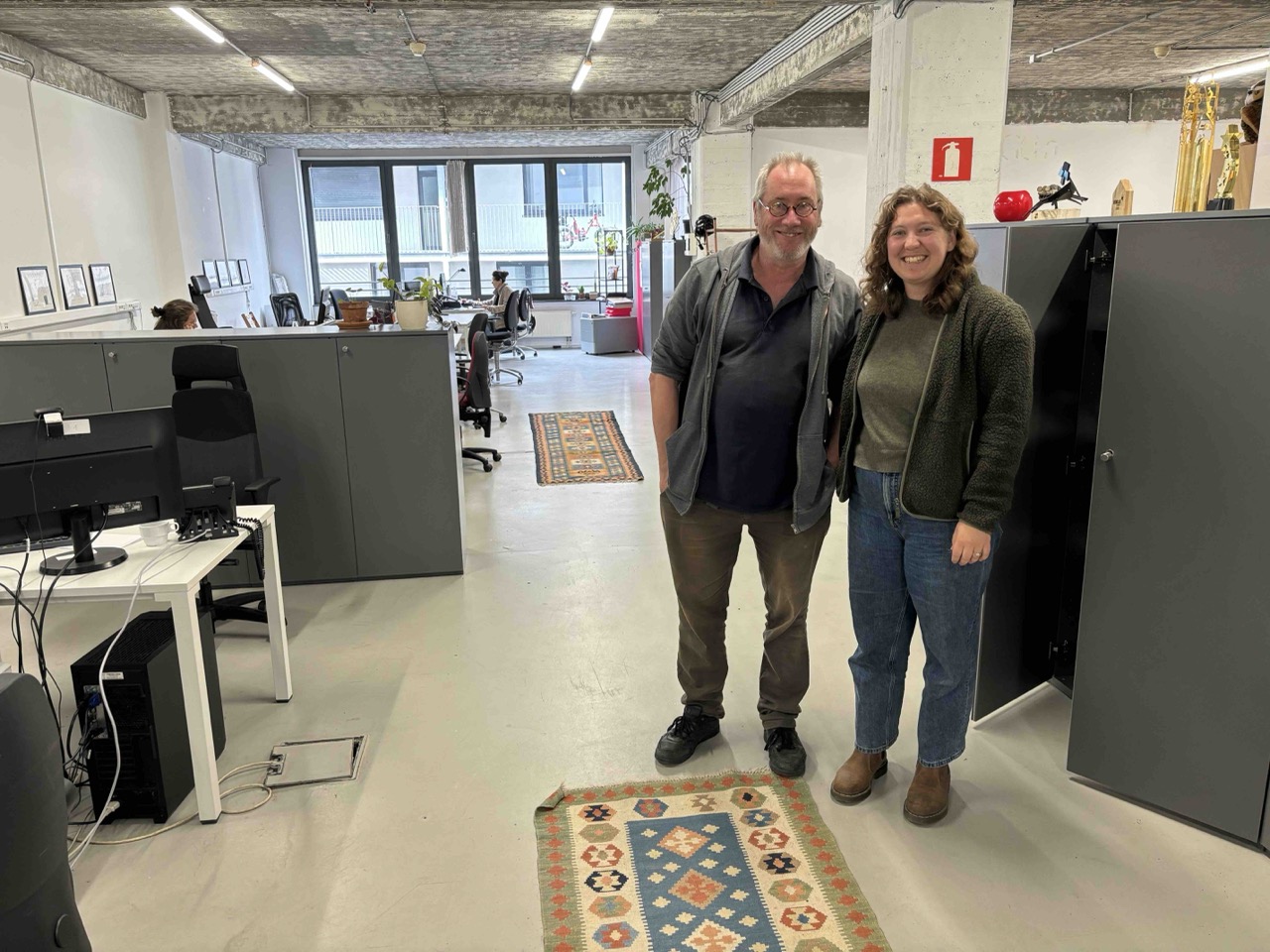 Geert and me in the Brussels CLT office
Geert and me in the Brussels CLT office
After the tour, Evrard and I walked forty minutes from Molenbeek to the CLT office downtown. They recently moved to a new, sleek space in the same building as the European CLT network. Over lunch at homemade plywood conference tables, I led a presentation about the Lopez CLT entirely in French. Staff were eager to learn about how LCLT combines the Community Land Trust model with co-operative housing and how our sweat equity program works (something Geert had interviewed Sandy about a few months ago). We compared challenges, such as finding access to long-term lending, in their case for residents, and in ours to co-ops, weighed the benefits of new construction vs. rehab, and reflected on how each ground lease is unique. It was amazing to see the flexibility of the Community Land Trust model working successfully in Brussels, the capital of the European Union, as well as on rural Lopez Island.
P.S. In another small world coincidence – it turns out that Evrard recognized Ségolène at the Brussels CLT: she had been at Camp Nor’wester, and after talking with us, realized she had even volunteered at LCLT as a camper! A long tradition that we continued this summer…
Thank you Camp Nor’wester Volunteers!
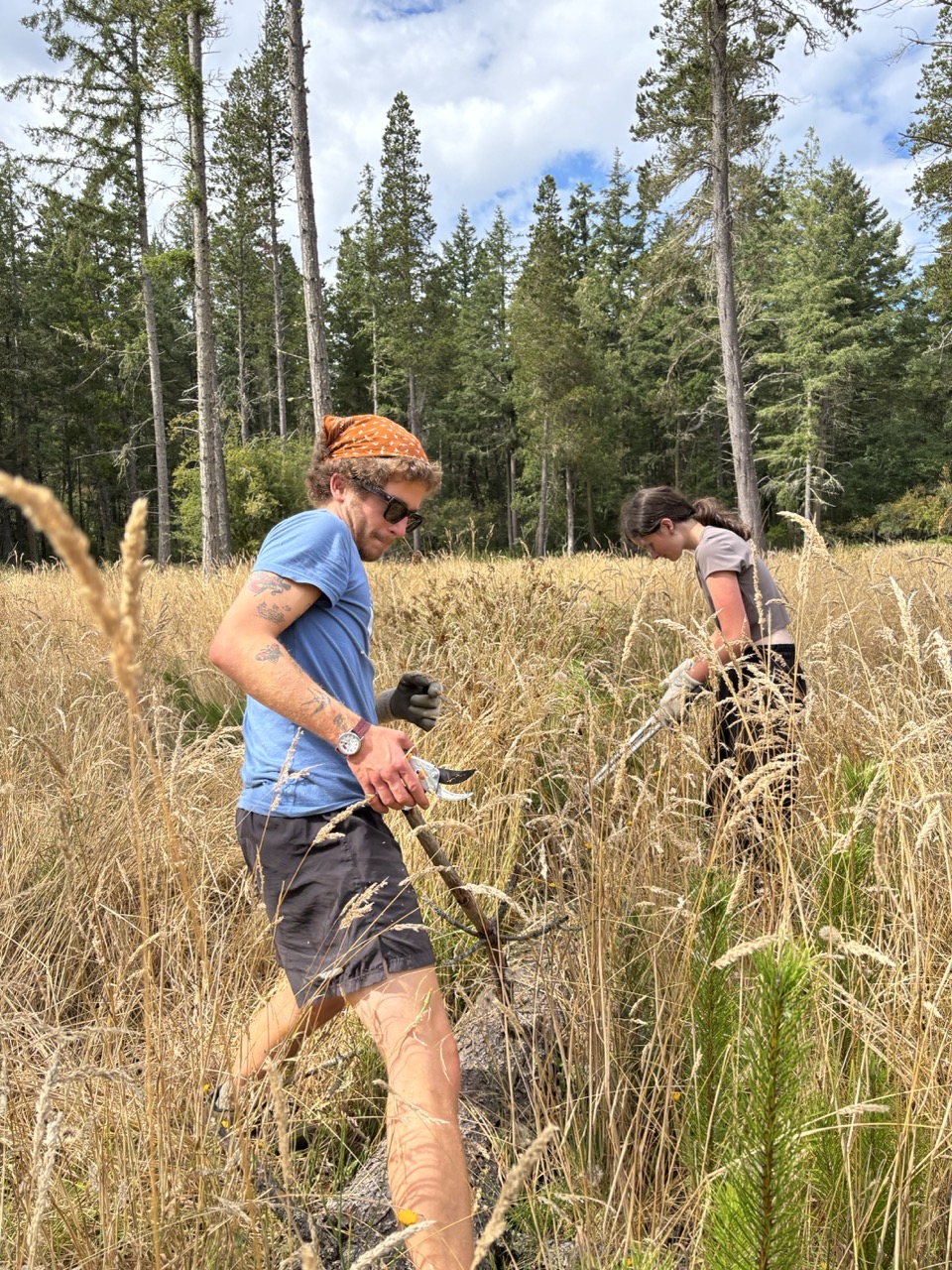
Two groups of campers from Camp Nor’wester came this summer to volunteer with LCLT. They helped with a variety of activities including building new trails and maintaining trails that campers from years past had built, moving leftover milled wood from the building site at Crayfish Way, tidying up there, and doing some fire prevention by cutting down small pine trees at the Portobello rental. It was meaningful for campers to contribute to LCLT and build on the work others had started before them. Reflecting after a day volunteering, one of the campers said, “it’s just really cool that other campers created trails where there are houses now, and we’re helping build trails where there might be houses in the future.” Camp Nor’wester has a motto “SJS means STO” which stands for “San Juan Spirit means Service to Others” – a motto which the campers truly embodied.
In Memory
~ Diana Luhn Bower ~
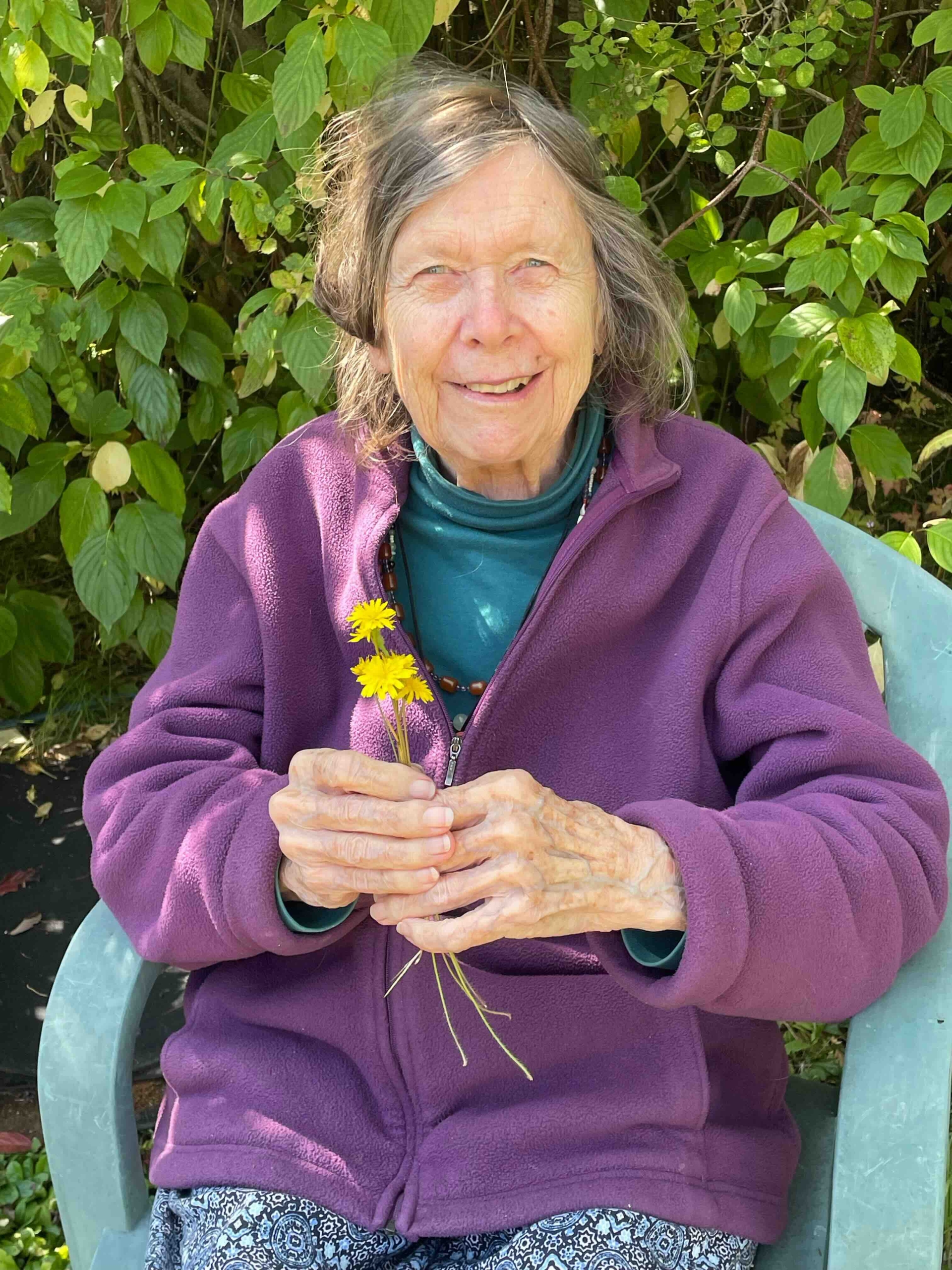 Photo by Sue DuMond
Photo by Sue DuMond
Diana Luhn Bower was 94 years old when she took her last breath on August 28, 2025 at 5:40 p.m.
Diana was born on November 22, 1930 in New York City to Hans Peter Luhn and Margaret Herreshoff and was the eldest of three children; her two brothers were named Peter and Chris. Her early life was much informed by her creative, inventive parents and aunts. Diana enjoyed a rich life as a traveler, a peace activist, an artist, community organizer and urban planner as well as a mother and wife. She was an intelligent creative who was a good friend to many. Before her long stretch of life on Lopez Island between 1981 and 2024, Diana lived a full life.
She sold her first painting when she was 15 years old and credits her high school teacher with prompting her to take her art seriously. Diana recalled, “I had always loved art – watercolors, costume design – and my art teacher said, “You’ve got to go to Yale. It’s the best art school I know of.” Until 1950, Yale followed the Beaux Arts tradition, and many of the classes took place in darkened rooms. After the first couple of years, Diana dreamed of a trip to Europe and through much hard work she earned her passage and spent most of the year soaking up art in Scotland, England, Paris and Florence. When she returned to Yale, the art school had been transformed. She found the students and professors lively, smiling and doing innovative work. It was at Yale that she fell in love with the letterpress, block prints, and later, graphic design. She practiced under the tutelage of Josef Albers who created the program at Yale and nominated her for the art prize she won in her senior year. Diana’s craft dates to the 15th century, and she often said her art was the reason she got up in the morning.
She graduated from Yale, married architect Ted Bower and settled in Seattle, where she had two children, Holly and Dan. She credits Holly and Dan with having a profound influence on her life. She said, “Their generosity and views about the world teach me so much. They taught me that inaction is a fruitless path, you have to take action.”
Diana was a woman of action through the peace movement and community development. She and her friends established the Madrona Preschool Enrichment program in the Central District, which became the pilot project for Head Start in the Seattle Public Schools. She was a community organizer with Seattle’s Model Cities program. Diana also worked as a graphic designer on projects for the Zoe Dusanne Gallery, UW Press and designed several books of NW Poets.
Years later, in the International District (ID), as an urban planner, Diana was active in securing the Asian Language Health Clinic and worked extensively on establishing the Hillside Community Garden and other community support organizations. She was an effective and diplomatic liaison between the City, County and ID community activists including Bob Santos. At the completion of her urban planning work in the neighborhood, she co-founded the Cicada Cooperative Art Gallery locating it in the ID.
While working on her PhD in Art History, Diana taught in the UW School of Urban Planning and was much liked and respected by her students and colleagues. She had an innate ability to understand how people best integrate within communities for the betterment of all, and her artistic eye for design as part of daily life influenced her work as a planner.
“In the early 1980’s Diana moved to Lopez to be closer to her daughter Holly (founder of Holly B’s Bakery) as well as her three grandchildren Ty, Rom, and Galen, in whom she took immense delight. She purchased the 1935 Homer’s farmhouse which she made into her studio, allowing her to focus even more on her art. Later Ted joined her. Here too, Diana continued her contributions as an artist and an activist. Many of us who live on Lopez Island associate Diana with Chimera Gallery, a cooperative art gallery she proudly co-founded with 14 other Lopez Island artists in 1986. She created the accompanying Chimera block print that is utilized as the gallery’s logo.
Diana saw the world in color, whether it was watercolor painting or creating her block prints, many of which she also painted. Combining prints with quotes that she referred to as “broadsides,” stringing exotic and rare beads for beautiful colorful necklaces or commenting on whether the shade of a shelf complimented or distracted from the paint on the wall, color was always in her mind. She had a unique ability to create beautiful and serene spaces with the simplest of objects. Diana was a longtime meditator, and shared on several occasions how her experiences in meditation inspired her art.
She had a strong commitment to justice. An arrest and trial resulting from protests to prevent nuclear annihilation, was life changing and furthered her resolve as a peace activist. One of her finest prints was “Cellblocks for Johnny”, a fellow protester, who was arrested and sentenced to time in jail.
Diana created and subsequently donated her art to causes that she believed brought more justice into the world. She was gifted with an intelligent wit, a retentive memory for poetry, music and Shakespeare and was not shy about expressing her views.
Diana’s friends and family were close by during her last days and enjoyed fleeting moments with her as she commented on her great love of the color of fresh flowers and her art that surrounded her.
For those of you wishing to purchase some of Diana’s prints, please come to the spring sale to benefit the Lopez Community Land Trust the week of March 17-22, 2026.
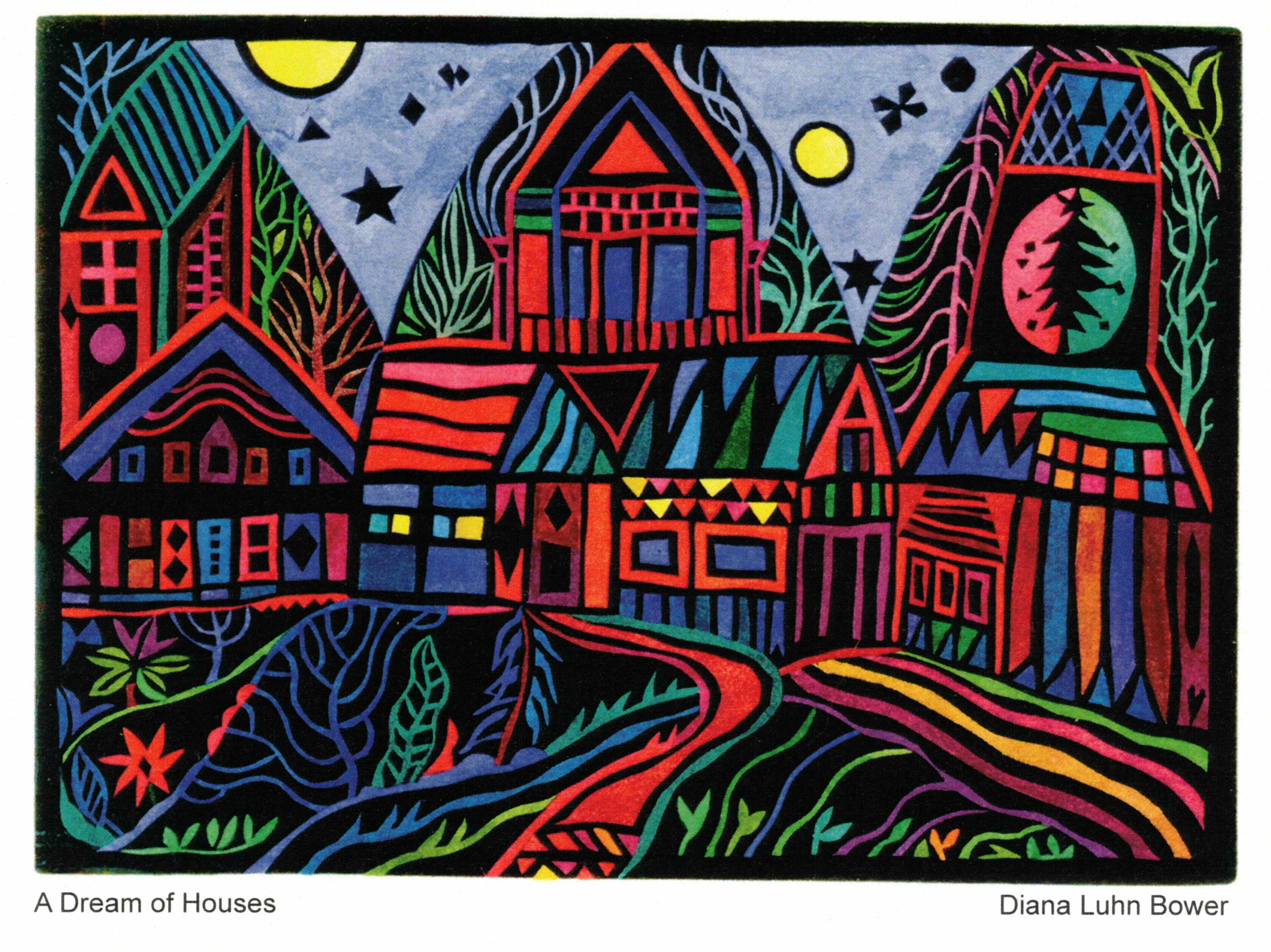 The logo Diana created for Lopez Community Land Trust
The logo Diana created for Lopez Community Land Trust
LCLT Board of Directors
Joe Schneider, Chair; Luis Cisneros, Vice Chair; Grant Carlton, Secretary; Eleanor Brekke, Treasurer; Carl Petterson, Eli Derzay, Hannah Rose, Jan Marshall, Jonathan Cargill, Mark Eames, Quaniqua Williams
Staff
Sandy Bishop, Executive Director; Breton Carter, Assistant Director
Marly Schmidtke, Administrative & Project Director
Rhea Miller, Community Liaison

